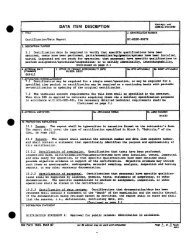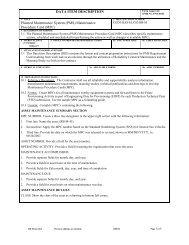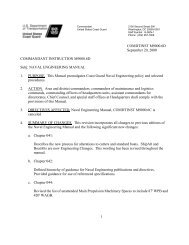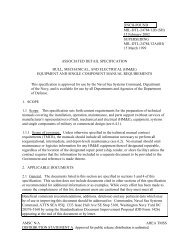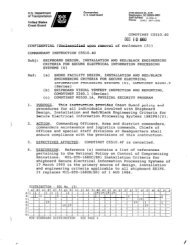comdtinst m2400.1f - US Coast Guard Response Boat-Medium
comdtinst m2400.1f - US Coast Guard Response Boat-Medium
comdtinst m2400.1f - US Coast Guard Response Boat-Medium
You also want an ePaper? Increase the reach of your titles
YUMPU automatically turns print PDFs into web optimized ePapers that Google loves.
provide frequency separation criteria between f1, f2, etc. If<br />
more than one frequency is required for the system and specific<br />
frequency separation criteria is not required, state; "Frequency<br />
separation not applicable".<br />
4.E.1. (f) Emissions. Emission(s) (see chapter 1).<br />
(g) Power. Maximum power for each emission.<br />
(h) Operation. Hours of operation.<br />
(i) Type. Type of service (point-to-point, ship/shore,<br />
air/ground, radionavigation, test and maintenance, etc.<br />
(j) Antenna Data. Antenna data (this data is required<br />
for all land station applications above 30 MHz).<br />
(1) Antenna name (generic preferred)<br />
(2) Orientation<br />
(3) Gain (nominal)<br />
(4) Site (terrain) elevation above mean sea level<br />
(5) Antenna height above terrain<br />
(6) Antenna polarization (required for assignments above<br />
420 MHz). For fixed (point-to-point) assignments,<br />
receiver location, coordinates and antenna data for<br />
receiving site is also required.<br />
(k) Equipment nomenclature. Equipment nomenclature: (this data<br />
required for all land station applications above 30 MHz).<br />
(1) If government equipment, list the government<br />
nomenclature for transmitter and receiver.<br />
(2) If commercial equipment, list name of manufacturer<br />
and model number of transmitter and receiver.<br />
(l) Mileage Radius and Number of Mobiles. Mileage radius and number<br />
of mobiles: (this data required for all land station<br />
applications above 30 MHz). List the area of operation as a<br />
milage radius and the number of mobiles extending from a given<br />
location, normally a base security or intelligence type of<br />
operation. Given location would be as indicated in (b) and (c)<br />
above.<br />
2. Authorization. Upon receipt of, and based on the foregoing, the<br />
Commandant (G-TTM) will evaluate the requirement for the radio<br />
frequency and, if approved, will obtain the necessary authorization.<br />
4.E.3. Special Frequency Requests. When a requirement exists for a <strong>Coast</strong><br />
<strong>Guard</strong> activity, within the United States and Possessions (<strong>US</strong>&P), to<br />
operate in local liaison nets with non-federal government<br />
organizations, a request<br />
4-4





